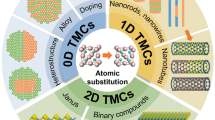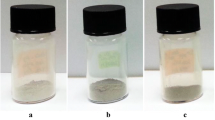Abstract
Doping the zirconium site in NASICON (Na3Zr2Si2PO12) with lower valent cations enhanced the ionic transport of the material. Both Na3.2Zr1.8M0.2Si2PO12 (M=Al3+, Fe3+, Y3+) and Na3.4Zr1.8M0.2Si2PO12 (M=Co2+, Ni2+, Zn2+) exhibited a higher bulk conductivity than undoped Na3Zr2Si2PO12 at room temperature. A decrease in the low temperature activation energy for all doped NASICON was observed, which helped contribute to the higher room temperature conductivity. The lower activation energy and enhanced conductivity of doped materials were a result of alterations in the NASICON structure. The charge imbalance created by aliovalent substitution increased the sodium in the lattice resulting in more charge carriers with better mobility. Furthermore, the conductivity was optimized by the ionic radius of the species in the zirconium site. Ultimately, NASICON doped with a +2 oxidation state cation having an ionic radius of approximately 0.73 Å (Zn and Co) attained a maximum in conductivity. Zn-doped NASICON displayed the greatest room temperature bulk conductivity of 3.75 × 10−3 S/cm, while Co-doped NASICON demonstrated the greatest total conductivity of 1.55 × 10−3 S/cm.





Similar content being viewed by others
References
Palomares V, Serras P, Villaluenga I, Hueso KB, Carretero-González J, Rojo T (2012) Na-ion batteries, recent advances and present challenges to become low cost energy storage systems. Energy Environ Sci 5(3):5884–5901
Yabuuchi N, Kajiyama M, Iwatate J, Nishikawa H, Hitomi S, Okuyama R, Komaba S (2012) P2-type Na(x)[Fe(1/2)Mn(1/2)]O2 made from earth-abundant elements for rechargeable Na batteries. Nat Mater 11(6):512–517
Noguchi Y, Kobayashi E, Plashnitsa LS, Okada S, Yamaki J (2013) Fabrication and performances of all solid-state symmetric sodium battery based on NASICON-related compounds. Electrochim Acta 101:59–65
Lalère F, Leriche JB, Courty M, Boulineau S, Viallet V, Masquelier C, Seznec V (2014) An all-solid state NASICON sodium battery operating at 200 °C. J Power Sources 247:975–980
Ellis BL, Nazar LF (2012) Sodium and sodium-ion energy storage batteries. Curr Opinion Solid State Mater Sci 16(4):168–177
Hayashi K, Shima K, Sugiyama F (2013) A mixed aqueous/aprotic sodium/air cell using a NASICON ceramic separator. J Electrochem Soc 160(9):A1467–A1472
Fergus JW (2012) Ion transport in sodium ion conducting solid electrolytes. Solid State Ionics 227:102–112
Hong HY-P (1976) Crystal structures and crystal chemistry in the system Na1+xZr2SixP3-xO12. Mater Res Bull 11(2):173–182
Goodenough J, Hong H, Kafalas J (1976) Fast NA+−ion transport in skeleton structures. Mater Res Bull 11(2):203–220
Boilot JP, Collin G, Colomban P (1988) Relation structure-fast ion conduction in the NASICON solid solution. J Solid State Chem 73(1):160–171
Fuentes R, Figueiredo F, Marques FM, Franco J (2001) Influence of microstructure on the electrical properties of NASICON materials. Solid State Ionics 140(1–2):173–179
Fuentes R, Figueiredo F, Marques FM, Franco J (2001) Processing and electrical properties of NASICON prepared from yttria-doped zirconia precursors. J Eur Ceram Soc 21(6):737–743
Miyajima Y, Saito Y, Matsuoka M (1996) Ionic conductivity of NASICON-type Na(1+x)M(x)Zr(2-x)P(3)O(12) (M=Yb, Er, Dy). Solid State Ionics 84(1–2):61–64
Saito Y, Ado K, Asai T, Kageyama H, Nakamura O (1992) Ionic conductivity of NASICON-type conductors Na1.5M0.5Zr1.5(PO4)3 (M:Al3+, Ga3+, Cr3+, Sc3+, Fe3+, In3+, Yb3+, Y3+). Solid State Ionics 58(3–4):327–331
Vonalpen U, Bell MF, Hofer HH (1981) Compositional dependence of the electrochemical and structural parameters in the NASICON system (Na1+xSixZr2P3-xO12). Solid State Ionics 3–4:215–218
Lloyd IK, Gupta TK, Hall BO (1983) Sintering and characterization of alkaline-earth-doped and zirconium-deficient Na3Zr2Si2PO12. Solid State Ionics 11(1):39–44
Gasmi N, Gharbi N, Zarrouk H, Barboux P, Morineau R, Livage J (1995) Comparison of different synthesis methods for NASICON ceramics. J Sol-Gel Sci Technol 4(3):231–237
Jolley AG, Taylor DD, Schreiber NJ, Wachsman ED (2015) Structural investigation of monoclinic-rhombohedral phase transition in Na3Zr2Si2PO12 and doped NASICON. J Am Ceram Soc. doi:10.1111/jace.13692
Bohnke O, Ronchetti S, Mazza D (1999) Conductivity measurements on nasicon and nasicon-modified materials. Solid State Ionics 122(1):127–136
Jamnik J, Maier J (2001) Generalised equivalent circuits for mass and charge transport: chemical capacitance and its implications. Phys Chem Chem Phys 3(9):1668–1678
Irvine JTS, Sinclair DC, West AR (1990) Electroceramics: characterization by impedance spectroscopy. Adv Mater 2(3):132–138
Acknowledgments
We would like to acknowledge the support of the US Department of Energy’s Office of Electricity Delivery and Energy Reliability and Sandia National Laboratories, contract # 1161548, for the financial support, Phil Piccoli for his operation of the electron probe microanalyzer, and the University of Maryland NISPLab for providing access to microprobe.
Author information
Authors and Affiliations
Corresponding author
Rights and permissions
About this article
Cite this article
Jolley, A.G., Cohn, G., Hitz, G.T. et al. Improving the ionic conductivity of NASICON through aliovalent cation substitution of Na3Zr2Si2PO12 . Ionics 21, 3031–3038 (2015). https://doi.org/10.1007/s11581-015-1498-8
Received:
Revised:
Accepted:
Published:
Issue Date:
DOI: https://doi.org/10.1007/s11581-015-1498-8




